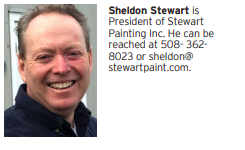By Sheldon Stewart
If you struggle with choosing the “right” color for your walls, you are not alone. It’s a commitment, one that can easily be changed, but when you are putting in the hard work of painting it yourself or paying someone else to do it, it’s a lot of pressure. This is in part because color is more than a visual experience. It is also a psychological one that affects emotions and moods. Maybe you want the room to create a certain feel, like calmness for a bedroom or an upbeat energy for a home office. Perhaps you are painting a reception area in an office and want to provide your visitors with a certain vibe.
Science of Color
There is actually a science to this and it is called the psychology of color. While reactions to color are subjective, research has actually been done to prove that certain color patterns provide certain reactions in humans.
Cool colors like blues, greens and purples can be calming, sophisticated and enchanting. Warm colors such as reds, oranges, and yellows can provide a sense of warmth, more energy, and optimism.
Color can also bring on physiological changes. Don’t believe it? A painting rep once shared that an office full of workers complained after a client changed the color of the office to a blue that it was too cold in the office. The company changed the color from blue to a peach color and these same workers started to take off their sweaters even though the thermostat was on the exact same setting. Amazing how the mind can play these tricks on us!
What the Colors ‘Mean’
Given all the colors in the world, and this is a short forum, we will provide some overviews of each general color. But it is important to keep in mind that within these colors are a wide variety of shades and that you can find the “right” shade for the emotion and feeling you want to evoke.
Blues: There is a reason why most people say their favorite color is blue. Blues are calming and cool and remind people of the sky and the ocean.
Greens: Greens remind people of nature. Greens can be calming and relaxing; however, certain shades can be joyful, harmonious, energized and full of life.
Purples: Purple has long symbolized royalty, luxury and wealth. However, it also represents imagination, creativity and even romance. You can create a sense of relaxation and serenity by choosing a calming shade of lilac.
Yellows: Yellow represents sun, summer, happiness, and optimism. Pale yellow can bring a sunny feel to a space without overwhelming to the senses.
Oranges: Orange demands attention and symbolizes warmth, vibrancy and enthusiasm. Orange, like red, can stimulate appetite and can spice up a dining room.
Reds: Red is the most stimulating of colors, psychologically speaking. It represents excitement and energy. It can stimulate appetite, which is why you will often see it used in dining rooms and restaurants.
Pinks: Pink is actually part of the red family but a very subtle side of it. Pink can be more tranquil, or in the case of hot pink, happy, energetic and full of life!
Black: Black can provide a sense of elegance and mystery, but use it sparingly. Too much black creates a sense of depression. Many will use it as a sophisticated accent wall. White: White can represent cleanliness and a cool refreshing feel — like a mint for your visual senses.
White is popular in the contemporary style. But white can also leave some feeling sanitized and cold. Warmer shades (there are so many shades of white) can make a room feel cozier.
Grays: Grays are classic, elegant and considered a neutral color (better for sale of homes). It works well with most colors and is the hot neutral color right now. If you watch HGTV you will see it used a lot right now.
Browns: Browns are considered an earthy tone that provides a feeling of security and contentment. Shades of brown are also a highly popular neutral. If you don’t see grays on HGTV, you will likely see a lot of brown tones.
Some Advice From the Experts First, you want to consider the primary function of the room. Second, you’ll want to pick a predominant color — the one that will be the key color in your color pattern. Color patterns are those combinations that create a friendly balance in the room. This doesn’t mean that you can’t use other colors in conjunction or as a decorating feature. Consider using some online tools such as Sherwin Williams ColorSnap® tools for the website, iPad, or iPhone and Android, or Benjamin Moore’s PERSONAL COLOR VIEWER® to help you find the color you think you want. You can then get a sample and try it on the wall you want to put it on and try a small section to see if you really like it before purchasing large cans of paint.
Don’t just paint; update your hardware too. Changing out door knobs, door hinges, and window hardware will make a huge difference in bringing a room up to date. Don’t worry about the time of year you paint. Once upon a time paint odors made people wait until it was warm enough to keep windows open to air out the house. Most of today’s paints are made using low to no VOC (volatile organic compounds). VOCs are solvents that get released into the air as the paint dries. So low-VOC and noVOC paints mean that painting indoors can be done anytime.
Finally, Choose Wisely According to current research, 80 percent of what we mentally absorb is visual. So choose the right colors and shades to achieve what you want yourself, family, friends or customers to feel.

The Psychology of COLOR

Select to Read Similar Content:




















